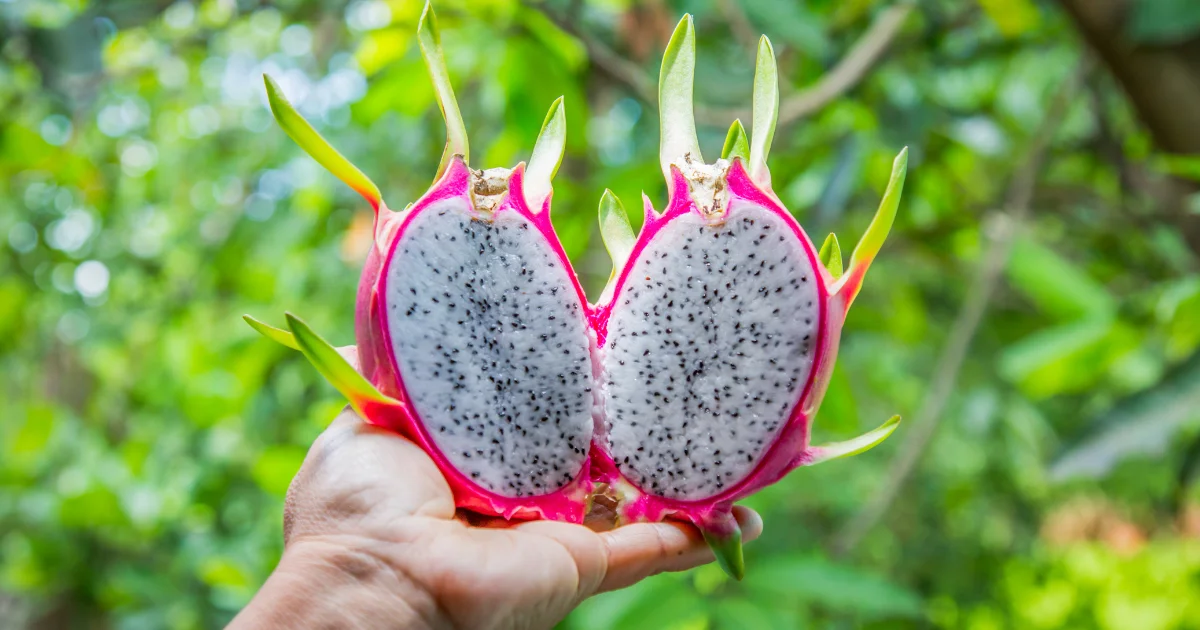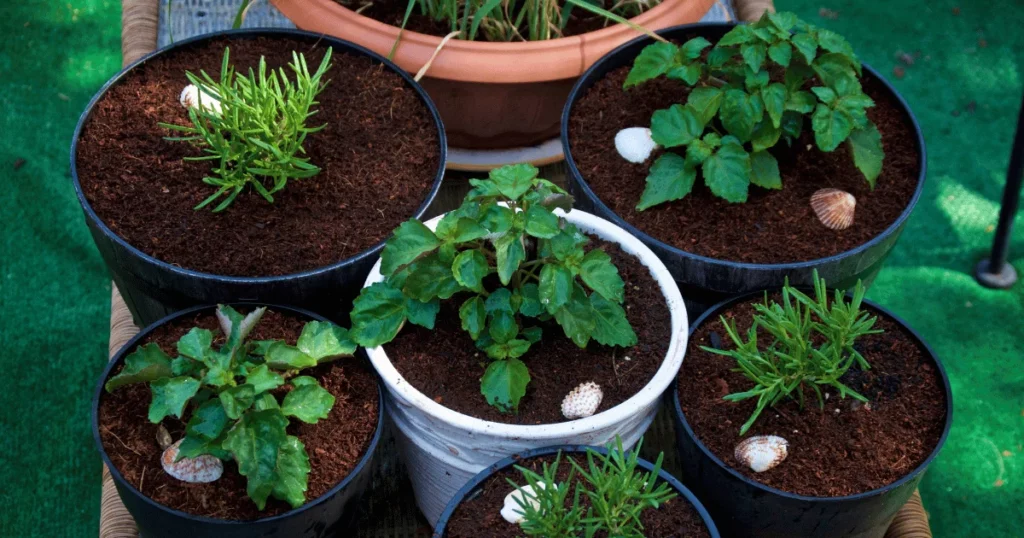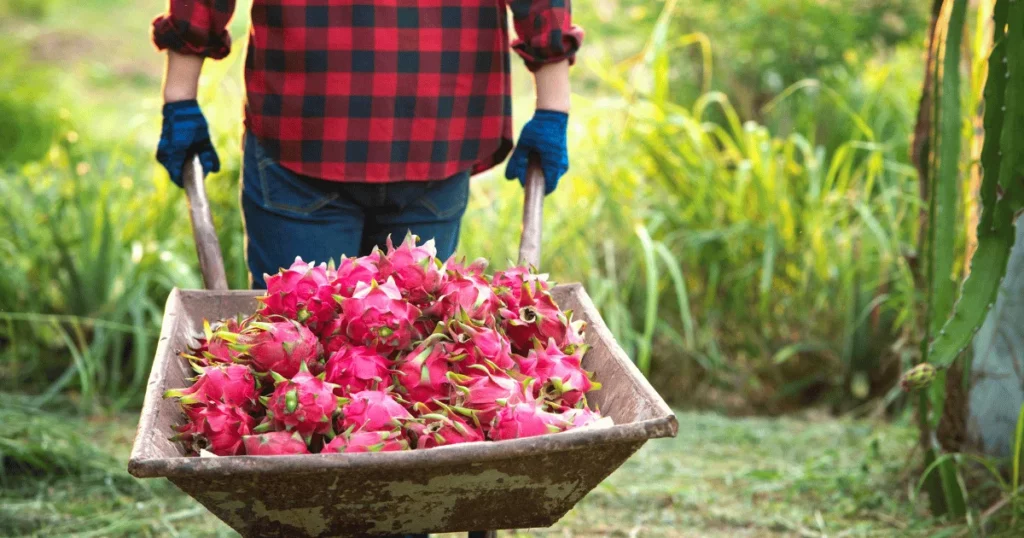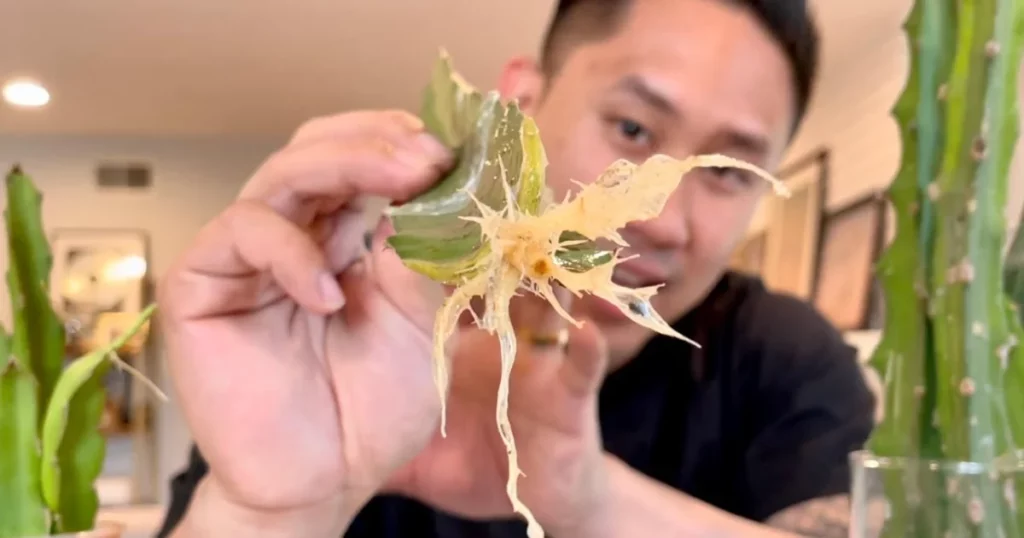Growing Dragon Fruit From Cuttings: A Detailed Guide

Are you intrigued by the exotic allure of dragon fruit and wish to cultivate your own? Wondering if you can grow dragon fruit from cuttings? Or, what’s the fastest way to root dragon fruit cuttings?” If these questions align with your curiosities, you’re in the correct place.
I’m here to guide you through the fascinating journey of propagating dragon fruit from cuttings. By the end of this article, not only will you learn how to grow dragon fruit roots from cuttings in water in just 1 week, but also discover how to nurture them into thriving, fruit-bearing plants.
How do you root dragon fruit fast?
Here’s a detailed breakdown of the factors and steps that can help expedite the rooting process of dragon fruit cuttings:
- To boost root development, dab a suitable rooting stimulant on the cut edge of the cuttings. It’s vital to pick a rooting hormone that’s deemed fit for dragon fruit cuttings.
- Embed the cuttings in a soil blend that drains well; an advisable mix is 80% standard potting soil and 20% coconut coir. This concoction aids in keeping the essential dampness while letting surplus water escape, crafting a perfect setting for rooting.
- Moisten the plants gently every few weeks or weekly, permitting the soil to somewhat dry between watering. Drowning the cuttings with water can lead to decay, so it’s pivotal to maintain a balance.
- Prior to planting, let the cuttings air-dry for approximately 7 days. This phase assists in healing the cut edge, diminishing the likelihood of decay when planted.
- Uphold a temperature bracket of 75°F to 85°F, as this is the optimum temperature for rooting dragon fruit cuttings. A lower temperature might obstruct the rooting endeavor.
Follow These 7 Steps to Grow Dragon Fruit From Cuttings:
Step 1: Getting Started with Dragon Fruit Cuttings
The journey of growing a dragon fruit plant begins with a cutting. Unlike other fruits, dragon fruit is propagated easily from cuttings, which are segments taken from a mature dragon fruit plant.
Plant the cut end about 2 to 3 inches into the soil, allowing the cutting to establish its root system and adapt to your soil conditions.
Step 2: Choosing the Right Container and Support

The next step is to transplant your rooted cutting into a suitable container. For those starting small, a 5-gallon container with a tomato cage for support is ideal.
However, if you plan on growing a larger plant, a 25-gallon container is recommended. Remember, pruning is key to preventing your dragon fruit plant from becoming unstable.
You May Also Like: Low-Maintenance Indoor Plants for the Living Room (Air Purifying)
Step 3: Preparing the Soil
Now the question is what potting mix is best for dragon fruit cuttings? The soil composition plays a vital role in the health and growth of dragon fruit plants. Opt for sandy loam soil enriched with organic matter, aiming for a pH level between 6 and 7. Enriching the soil with composting manure, especially during spring, is beneficial.
For dragon fruit cuttings, a mixture comprising 1/3 cactus mix and 2/3 organic, pre-mixed potting soil is effective. This should include components like perlite, compost, peat moss, and other nutrients to foster robust growth.
Another viable option is a blend of cocopeat, compost, and red soil. It’s advisable to layer the top with cactus-friendly potting soil. This combination ensures the soil remains well-drained, a critical factor to prevent root rot and deter pests like aphids.
It’s best to avoid synthetic fertilizers and instead use a balanced mix of compost and organic matter. Adding perlite to your soil mix enhances drainage, further supporting the healthy development of dragon fruit plants.
Step 4: Sunlight Requirements
Sunlight is critical for dragon fruit plants, especially for fruiting. However, during the early months, ensure your cutting gets some shade. As the plant matures, it will require full sun.
If the color turns a light lime green to almost yellow, it’s just perfect; but too much yellow indicates sunburn.
Related: Best Gardening Tools Names with Pictures
Step 5: Watering Your Dragon Fruit Plant
Watering requirements will depend on your area’s climate. In hot, humid, and rainy regions, minimal watering is needed. However, during dry periods, regular watering is necessary to keep your plant healthy.
While dragon fruit doesn’t require a lot of fertilization, a balanced slow-release fertilizer applied in the growing season can promote growth.
Step 6: Pruning and Supporting Your Dragon Fruit Plant
Pruning helps to maintain the shape and size of the plant, making it easier to access the fruits during harvest. So, remove dead or dying stems to encourage new growth.
The support structure is equally important; ensure you have a sturdy support structure like a trellis or cage to encourage upward growth.
See Also: How to Prune Creeping Phlox in Winter
Step 7: Anticipating Fruit Bearing
Patience is key as it may take 6 to 14 months post-rooting for your dragon fruit plant to start bearing fruit. The wait will certainly be worth it as you enjoy fresh dragon fruit harvested right from your garden.

Related FAQs
What do dragon fruit roots look like?
Dragon fruit plants have shallow, delicate roots that grow close to the soil surface, extending 20-30 cm, and deeper (45-63 cm) before fruiting. These thin roots emerge from the plant’s stems and are epiphytic, helping the plant attach to supports without being parasitic. They are essential for stability and nutrient absorption.

Can you grow dragon fruit from store-bought fruit?
You can cultivate dragon fruit using seeds from a fruit you’ve purchased at the store. Here’s how: extract some seeds from the fruit’s flesh, cleanse them to remove any fruit residue, and let them dry. Next, sow these seeds in a specialized cactus soil blend.
To maintain adequate moisture for germination, cover the container with a clear plastic sheet. It’s important to note that a dragon fruit plant started from seeds may take quite a few years, possibly up to five, to start producing its own fruit.
Why are my dragon fruit cuttings not growing?
Dragon fruit cuttings require a warm, sunny environment and well-draining, sandy soil to grow. Over-watering or poor drainage can lead to rot. It’s crucial to plant them at the right depth, about 2 to 3 inches into the soil, and allow time for rooting. Additionally, a balanced fertilizer can support healthy growth.
How long does it take a dragon fruit cutting to produce fruit?
The duration it takes for a dragon fruit cutting to bear fruit can vary based on several factors including the climate, the health of the cutting, and the care it receives. Here’s a breakdown of the information gathered from various sources:
- Tropical Climates: In tropical climates, it may take approximately 14 months from the time of planting a cutting for a dragon fruit to bear fruit.
- Optimized Conditions: There’s mention of a method that could potentially lead to fruit production in as little as 6 months. This involves cutting a full segment from a mature plant, making a slanted cut at the open end, treating it with fungicide, and then allowing it to “cure” in a dry, shady place for a week before planting.
- Flowering to Fruiting: Under the right conditions, a dragon fruit plant will flower after 6 to 8 months and will bear fruit shortly after that.
See Also: What Fruits Grow in 30 Days
Conclusion
In this guide, we’ve explored how to grow dragon fruit from cuttings, covering planting, soil preparation, sunlight, water, and troubleshooting growth issues. By following these guidelines, you can look forward to nurturing your cuttings into thriving plants, eventually enjoying homegrown dragon fruits from your garden.
